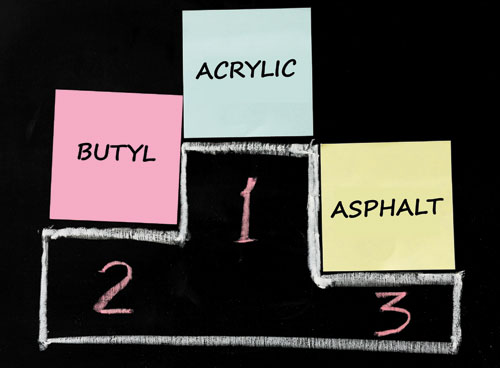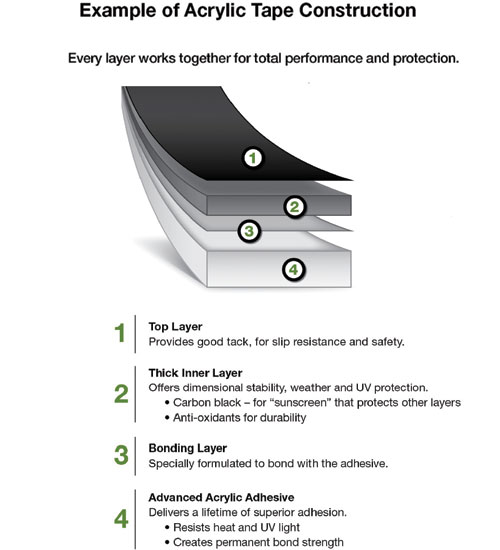Acrylic Flashing Tape Keeps It Together
The Evolution of Construction Tapes
Building materials are constantly evolving, with manufacturers offering new and improved products that contribute to a building's energy performance and service life. Construction tapes are no exception, and relatively recent advances have shown superior durability and performance under a range of temperature and climate conditions.
Asphalt Tapes
It used to be that most construction tapes were asphalt-based tapes. Asphalt tapes are made from modified bitumen, similar to the rubberized asphalt commonly found in eaves flashing. Though widely used, asphalt tapes have several drawbacks. They are messy to install, and their durability is often of questionable quality. A priming may be required to achieve a full bond with some substrate materials, such as oriented strand board (OSB) and concrete, which may present particular problems for certain asphalt flashings.
Asphalt tapes also have a poor temperature range. According to the Encyclopedia of Building & Environmental Inspection, Testing, Diagnosis, Repair, many rubberized asphalt products start to lose stickiness at around 50°F and have problems bonding below 40°F. Unless the rubberized-asphalt product is specifically formulated for low temperatures, other products are a better choice in colder weather situations. Problematic application also applies when asphalt tape is subjected to high temperature or direct and prolonged sunlight. The asphalt will soften and begin to flow between 185°F and 210°F. Some asphalt membranes are specially formulated for high-temperature situations and can withstand temperatures of up to 240°F, though they are typically not as sticky.
Butyl Tapes
Butyl rubber is a synthetic rubber, or elastomer, a copolymer of isobutylene with isoprene. It is impermeable to air and used in many applications requiring an airtight rubber. Butyl tape has a butyl rubber core, and has an expanded temperature range and greater durability than its asphalt counterpart, that is, it stays more flexible in cold weather and is more stable at high temperatures than asphalt tapes. Compared to asphalt tapes, butyl products form better bonds with difficult substrates and can be peeled off and adjusted during installation. However, butyl-based tapes are often susceptible to UV degradation, drying, and degradation of its adhesive properties. The temperature range is greater than asphalt, with application from 40 to 120°F, and service from -40 to 200°F. Typical recommendations are to avoid installation below 40°F unless it can be verified that the surface is free of moisture and contaminants. There are some tapes that can be installed in lower temperatures with the use of a primer.
 |
|
Illustration courtesy of Huber Engineered Woods |
Acrylic Tapes
Acrylic tapes are engineered for superior durability and temperature range and have been shown to perform so well that they are routinely used not only in the construction field but in high-performance applications in the automotive, marine, and aviation industries as well.
Water-based, solvent-based, or “solid,” acrylic tapes are becoming increasingly popular. The least expensive acrylic tape is water-based; however, this type of tape may not bond to as many types of substrates as the other varieties. According to BuildingGreen.com, “solid acrylic adhesives can form the strongest adhesive bonds at a wide range of temperatures and even achieve adhesion to damp or wet substrates.” Without solvents, the tapes do not become brittle over time.
 |
Illustration courtesy of Huber Engineered Woods |
Advanced acrylic adhesive is made of highly polar molecules, meaning a magnetic-like attraction pulls the adhesive into the substrate. Some acrylic tapes are formulated to flow into every crevice, increasing total contact area. This helps the tape wet out well, flowing into surface inconsistencies to produce a permanent bond. The result is a superior, lasting seal that is considerably stronger than traditional asphalt and butyl tapes. With both robust adhesion and cohesion, advanced acrylic tapes are internally strong—intertwined polymer chains provide excellent internal strength, adding to the overall reliability of the seal.
Using acrylic tape to seal high-performance wall panels is gaining popularity in the building industry. Builder Paul Fournier of Lewiston, Maine, is enthusiastic about the convenience afforded by that scenario. “We built the walls on the floor, taped them, installed windows, and raised them and were ready for siding. No having to deal with housewrap that would blow away,” Fournier says. “Same with the roof, we installed it, taped it, and were ready to roof it without having to worry about underlayment.” Builder Miguel Hewett of Southport, North Carolina, had a similar experience. “The high-performance roof saved me so much time because you just put in the panels and tape and you're done. There's no felt or rework. It hardly took any time for my crew to learn how to use the tape, and it just gets easier every time they use it.”









